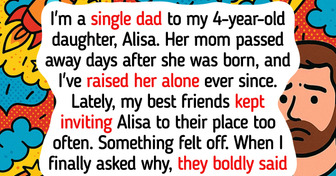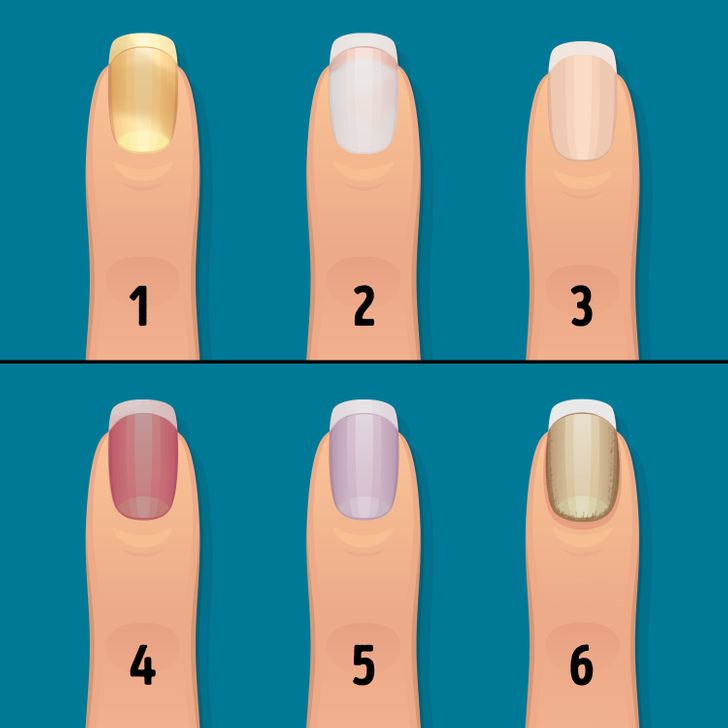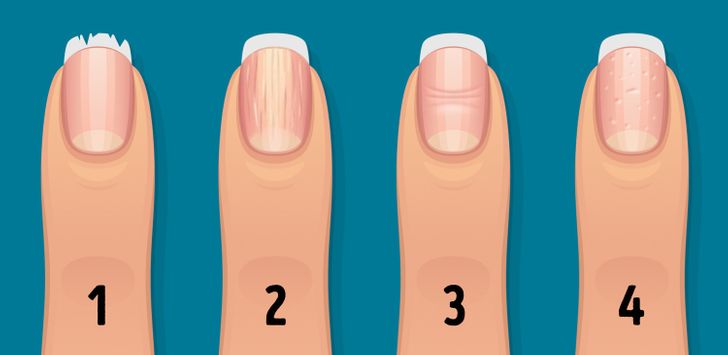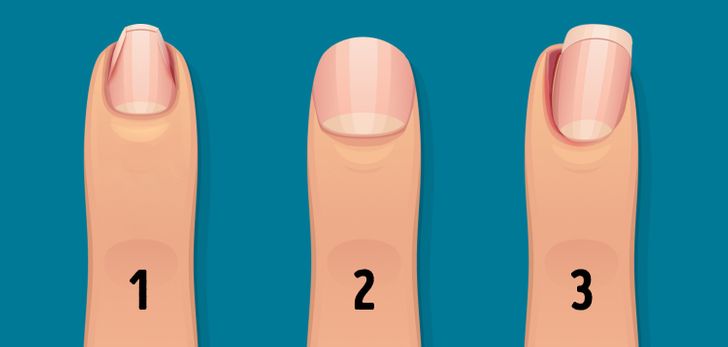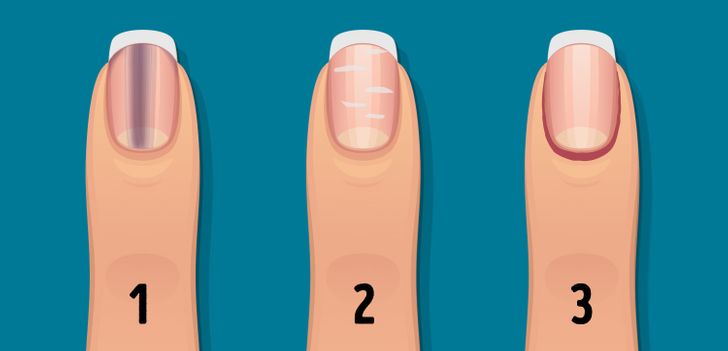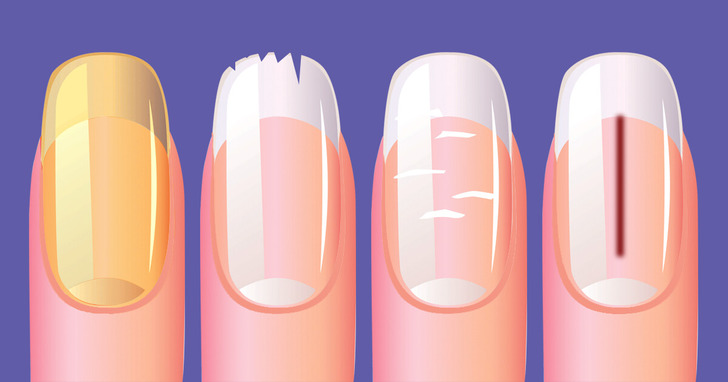I do NOT like the 3 NO WEY I LIKE IT 1 BIT 0% LIKE IT!!!!! ):
16 Things Your Nails Can Say About Your Health
Today, nails are mostly regarded as a purely aesthetic feature of our bodies. In fact, it is estimated that the global nail polish market will reach up to $15.55 billion by 2024. However, it turns out that your nails may not just be a platform of contemporary design but also a mirror of your general health status.
The color of your nails
- In most cases, yellow nails indicate a fungal infection. If not treated in time, this condition may worsen and your nails may even acquire a greenish tint and become crumbly. Other possible causes of the yellow color include aging, lung issues caused by smoking, and frequent usage of low-quality acrylic nails.
- White nails with a strip of pink at the top (or Terry’s nails) can be a sign of congestive heart failure, kidney failure, diabetes, and some liver problems such as hepatitis or cirrhosis. Sometimes Terry’s nails may also be caused by aging.
- If your nails are extremely pale, you probably have a nutritional deficiency or a circulation problem that prevents the blood from reaching your fingertips. In severe cases, this may even lead to anemia or an iron deficiency in your blood.
- Dark red nails may indicate that you have heart disease. If the redness extends to the sides of your nails and cuticle, this might be a sign of an autoimmune disease called lupus.
- Bluish or purple nails usually mean that your body doesn’t get enough oxygen. Among other possible causes are heart issues and lung problems such as emphysema and chronic bronchitis.
- Other colors of your nails may be a sign of various health problems. For example, if your nails turn brown, this may indicate that you have a thyroid disease or nutritional problems. Grey tinted nails are usually caused by taking some prescription drugs like antimalarial pills.
The texture of your nails
- Brittle, split nails are usually linked to hypothyroidism, a condition when your thyroid works too slowly. Dry and crumbly nails also may indicate a deficiency in vitamins A, C, and the vitamin B7 also known as biotin. Another possible reason for this nail problem is the overuse of nail polish remover.
- Vertical ridges are usually a normal sign of aging, just like wrinkles on your face. But if they become more prominent at a young age, this may mean that you suffer from vitamin B12 or a magnesium deficiency.
- Horizontal ridges (or Beau’s lines) are typically the result of direct trauma to your nail. However, if you see them on more than one nail at a time, they may also be a sign of a serious illness with a high fever such as scarlet fever or pneumonia.
- Nail pitting may indicate skin problems such as psoriasis, eczema, and dermatitis. It may also be an early sign of connective tissue disorders including inflammatory arthritis, a disease that affects your joints.
Nail growth
- Spoon nails (or koilonychia), a phenomenon when your nails look like a spoon with raised ridges and a scooped out depression, may be a sign of hemochromatosis, a disorder that occurs when your body produces too much iron. They’re also associated with iron-deficiency anemia, heart disease, and poor blood circulation.
- Nail clubbing appears when your fingertips become enlarged and your nails become curved downward. This kind of nail growth can be a sign of low oxygen in your blood that is usually caused by lung disease. Clubbing can also be related to liver or kidney disease, heart problems, inflammatory bowel disease, and AIDS.
- Nails that are detached from their beds usually indicate hyperthyroidism, a condition when your thyroid gland is releasing too many hormones into your body. Loose nails can also signify a fungal infection, psoriasis, poor blood circulation or amyloidosis, or an excess amount of the protein amyloid in your organs and tissues.
Other nail features
- Dark verticle lines extending from the cuticle to the tip of your nail may be a sign of subungual melanoma, a really dangerous type of skin cancer. So even if those lines don’t cause any pain in your nails, it’s better to make an immediate trip to your doctor once you’ve noticed them.
- Although most people believe that white stripes (or Mees’ lines) mean calcium deficiency, that’s not actually true. Those white discolorations on your nails usually indicate an imbalanced diet lacking in protein. Besides that, they may appear after an episode of poisoning with heavy metals as a result of kidney failure.
- Red, puffy skin around your nail usually indicates inflammation of the nail fold. If the inflammation is accompanied by large swelling, this could be due to an infection called paronychia. Other possible reasons for the reddish nail fold include connective tissue disorders — lupus disease, in particular.
Bonus: How to make your own nail remedy at home
Take 4 oz of jojoba oil, 4 oz of vitamin E oil, 3 oz of avocado oil, 2 oz of grapeseed oil, and 2 oz of sweet almond oil, and mix them well in a nail polish bottle. Apply this mixture to the entire cuticle area and massage it into the skin around your nails. Then rub excess oil into your hands as if it was hand lotion. Repeat the procedure as often as you wish, especially after any contact with water.
This home remedy will help you properly hydrate your nails and cuticle so that the skin around your nails will become much healthier and softer.
The information presented above is for informative purpose only. So if you’ve noticed any of these changes in your nails, don’t forget to consult your doctor first to find out if you actually need any special treatment or not.
Comments
everything is bad here lol
Related Reads
18 Individuals Who Effortlessly Put Insolent People in Their Place

I Refused to Give Up My Table to a Family—I Was the One Who Booked It
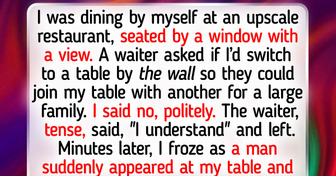
20 Real-Life Stories That Are More Chilling Than a Stephen King Novel

11 True Stories That Took Us on an Emotional Roller Coaster

17 Stories About Christmas Parties That Ended Up in Disaster

20+ People Who Have Concrete Evidence That Absurdity Has No Limits
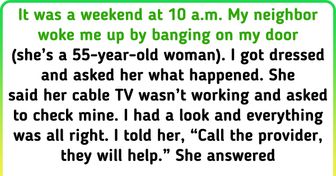
9 People Share Impossible Events That Horrified Them to Their Core
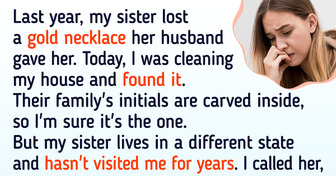
12 Real Stories of Strangers Who Made a Lasting Impression on People
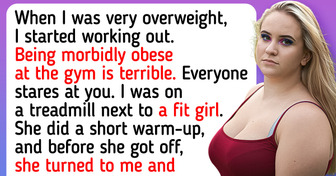
12 Family Secrets That Could Outdo a Hitchcock Thriller
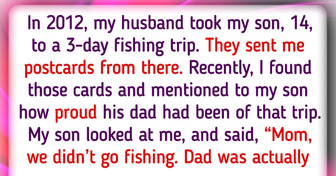
My DIL Insulted Me Being Unaware I Was Supporting Their Family, My Revenge Made Her Turn Pale
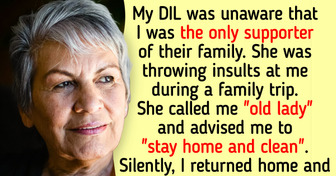
14 People Who Have Scratched the Word "Shame" Out of Their Dictionary
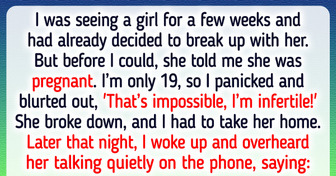
I’m a Single Dad and My Friends Have Secret Plans for My Daughter—I’m Furious
